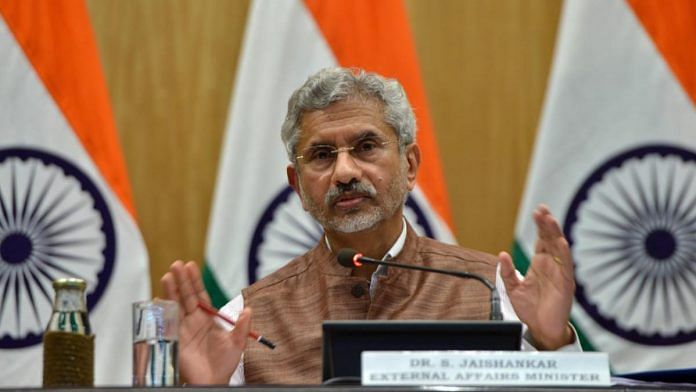
New Delhi: Amid continued tensions in the Ladakh sector of the Line of Actual Control (LAC), External Affairs Minister S. Jaishankar Wednesday said the bilateral relationship between India and China has been “significantly damaged” this year.
Addressing a webinar organised by the Lowy Institute, an Australian think-tank, Jaishankar said today’s China is “much more nationalistic” and that it cannot be business as usual with Beijing as long as soldiers at the border are in a stand-off.
“There has been an evolution in China … 2008-2009 was the tipping point for that change and you have today a China whose engagement with the world is very different from the way it used to be 20 years ago,” he said.
“You could argue that it is natural for a country that goes up the power hierarchy, that its behaviour and pattern would change. I reserve my comment on it. But clearly no question that you have a very much more nationalistic China and that is expressed down the line in a variety of ways and often in policies as well.”
Referring to his book, The India Way: Strategies for an Uncertain World, and what he has written about China and its President Xi Jinping, Jaishankar said, “We are today probably at the most difficult phase of our relationship with China, certainly in the last 30-40 years you could argue even more. The last time there were military casualties on our borders was in 1975, so just to give you a sense of a time there.
“We have this problem (with China) because from 1988 our relationship, which had hiccups, we had issues, differences, I am not in denial of that, but if you look at the direction of ties, the direction of the ties probably were positive,” he added.
“Thirty years ago there was virtually no trade with China. Today, China is our number two trade partner after the US. There was no travel with China… We engaged with each other in pretty much every domain.”
The external affairs minister, however, said all this was dependent on the fact that while both sides were dealing with the question of the settlement of the boundary there will be “peace and tranquillity” in the border areas.
He said while smaller skirmishes over border patrolling did take place they were more or less resolved and there was never a “major breach” of the understanding, alluding to the bilateral agreements both countries have on maintaining peace in the border areas and not to bring in a large number of troops there.
“We had multiple agreements starting from 1993 that essentially asked both parties not to bring large forces to the boundary. Now for some reason, for which the Chinese have given us five different explanations, the Chinese have violated it,” he said. “The Chinese have literally brought tens of thousands of soldiers in full military preparation mode right up to the Line of Actual Control in Ladakh. Naturally, the relationship would be profoundly disturbed by this.”
Bringing India-China ties ‘back on track’
The border stand-off that began in April-May is now into its eight-month and both sides are ready for a long haul through the winter. The current stand-off also witnessed the killing of 20 Indian soldiers in June at the Galwan River Valley while the Chinese never revealed the number of casualties they had suffered in that clash.
“What has happened and when you have soldiers very close up and it was not entirely surprising that something went horribly wrong,” Jaishankar said. “We have had 20 casualties out there and it has completely changed national sentiments.”
He, however, said that talks are ongoing to resolve the matter but reiterated that it cannot be business as usual unless the situation at the LAC changes.
“Today, how we get the relationship back on track is a very big issue and we are very clear that maintaining peace and tranquility along the LAC is the basis for the rest of the relationship to progress,” Jaishankar, who was India’s Ambassador to China, said. “So you can’t have the kind of situation you have on the border and say let’s carry on with life in all other sectors of activity. It’s just unrealistic.”
The former foreign secretary also added, “The relationship, very frankly, this year has been very significantly damaged.”
Subscribe to our channels on YouTube & Telegram
Why news media is in crisis & How you can fix it
India needs free, fair, non-hyphenated and questioning journalism even more as it faces multiple crises.
But the news media is in a crisis of its own. There have been brutal layoffs and pay-cuts. The best of journalism is shrinking, yielding to crude prime-time spectacle.
ThePrint has the finest young reporters, columnists and editors working for it. Sustaining journalism of this quality needs smart and thinking people like you to pay for it. Whether you live in India or overseas, you can do it here.